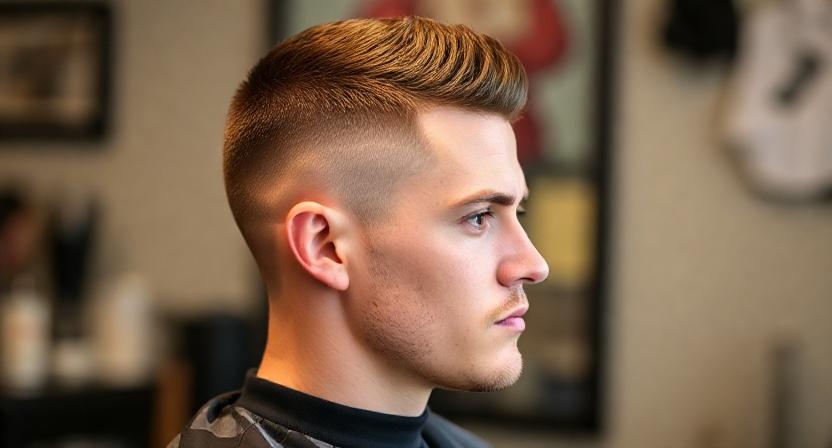The crew cut is more than just a popular hairstyle; it's a cultural icon with deep roots in military tradition and a lasting influence on modern fashion. Known for its clean, low-maintenance look, the crew cut has evolved over decades, maintaining its relevance across generations and trends. In this article, we'll explore the history, different styles, cultural significance, grooming tips, and its modern-day appeal.
Origins and History of the Crew Cut
The crew cut's origins trace back to military and athletic settings in the early 20th century. Originally adopted by soldiers for its practicality, the style was designed to keep hair short and manageable, especially in demanding environments. Its name is believed to derive from the "crew" of sailors or soldiers who sported the look, emphasizing its association with discipline, uniformity, and functionality.
During World War II, the crew cut gained popularity among servicemen, symbolizing strength and professionalism. Post-war, returning veterans and athletes embraced the style, which quickly became a staple of men's grooming. Over time, the crew cut transitioned from a purely utilitarian hairstyle to a fashionable choice embraced by civilians of all ages.
Variations of the Crew Cut
While the classic crew cut features short sides and a slightly longer top, there are various styles tailored to personal preferences and face shapes:
-
The Ivy League: Also known as the Princeton, this style features a slightly longer top that can be parted or styled with a side part, offering a more polished look suitable for professional settings.
-
High and Tight: Popular among military personnel, this variation has very short sides and back with a slightly longer top, emphasizing a clean and sharp appearance.
-
Textured Crew Cut: Incorporates layered styling to add volume and texture on top, providing a modern twist suitable for casual and contemporary fashion.
-
Fade Crew Cut: Features a gradual taper from the sides to the top, blending styles like fades and undercuts for a more dynamic appearance.
Cultural Significance and Modern Relevance
The crew cut historically symbolized discipline, masculinity, and military service. Over the decades, it has come to represent practicality and simplicity, but also a sense of confidence and self-assurance. Hollywood stars and athletes, such as Steve McQueen, David Beckham, and Chris Evans, popularized variations of the crew cut, cementing its status as a timeless masculine hairstyle.
Today, the crew cut continues to be relevant, especially among young men seeking a stylish yet low-maintenance haircut. Its versatility allows it to adapt to different fashion trends, from classic to modern edgy looks. The hairstyle also resonates with those who prioritize convenience without sacrificing style.
Why Choose a Crew Cut? Advantages and Disadvantages
Advantages:
- Low Maintenance: The short length means less frequent washing and styling.
- Comfort: Ideal for hot climates or active lifestyles, as it keeps the head cool.
- Versatility: Suitable for various occasions, from casual to formal.
- Timeless Appeal: Its classic look transcends trends, making it a safe choice for many.
Disadvantages:
- Frequent Trims Needed: To maintain its sharp look, regular visits to the barber are necessary.
- Limited Styling Options: The short length restricts the ability to experiment with different hairstyles.
- Potential for Uneven Growth: Growing out the style can be uneven, requiring patience during transition periods.
Grooming Tips for a Perfect Crew Cut
Maintaining a crew cut involves simple grooming routines:
- Regular Trims: Schedule visits to the barber every 2-4 weeks to keep the shape sharp.
- Use of Styling Products: A light pomade or styling cream can add texture and hold, especially for textured variations.
- Scalp Care: Keep the scalp clean and moisturized to avoid dryness or irritation.
- Face Grooming: Complement the hairstyle with well-maintained facial hair for a cohesive look.
The Crew Cut in Modern Fashion
In contemporary style, the crew cut remains popular among athletes, military personnel, and fashion-conscious men. Its adaptability makes it suitable for various face shapes and hair types. Modern trends have seen the integration of fades, undercuts, and textured tops, offering a personalized touch to the classic style.
Celebrities and influencers continue to sport crew cuts, demonstrating its versatility—from rugged and masculine to sleek and professional. Its minimalist appeal aligns with the current preference for low-maintenance yet stylish grooming.
Read more: https://crewcut.uk/hair-care-keratin-benefits-for-crew-cut-hairstyles-in-2025/
Deciding if a Crew Cut is Right for You
Choosing a hairstyle is a personal decision influenced by face shape, hair texture, lifestyle, and aesthetic preferences. The crew cut suits many face shapes, especially oval, square, and heart-shaped faces. It complements various hair types, from straight to wavy.
If you value practicality, cleanliness, and a timeless look, the crew cut might be an excellent option. Consulting with a professional barber can help customize the style to suit your features and desired appearance.
In Summary
The crew cut is a versatile, practical, and stylish hairstyle with a rich history rooted in military tradition. Its various styles can be adapted to fit modern fashion trends, making it a popular choice across generations. Whether you prefer a clean, professional look like the Ivy League or an edgier fade, the crew cut offers a timeless appeal that balances ease of maintenance with masculine confidence. If you're considering a change, the crew cut remains a reliable and stylish choice that can elevate your grooming game for years to come.

